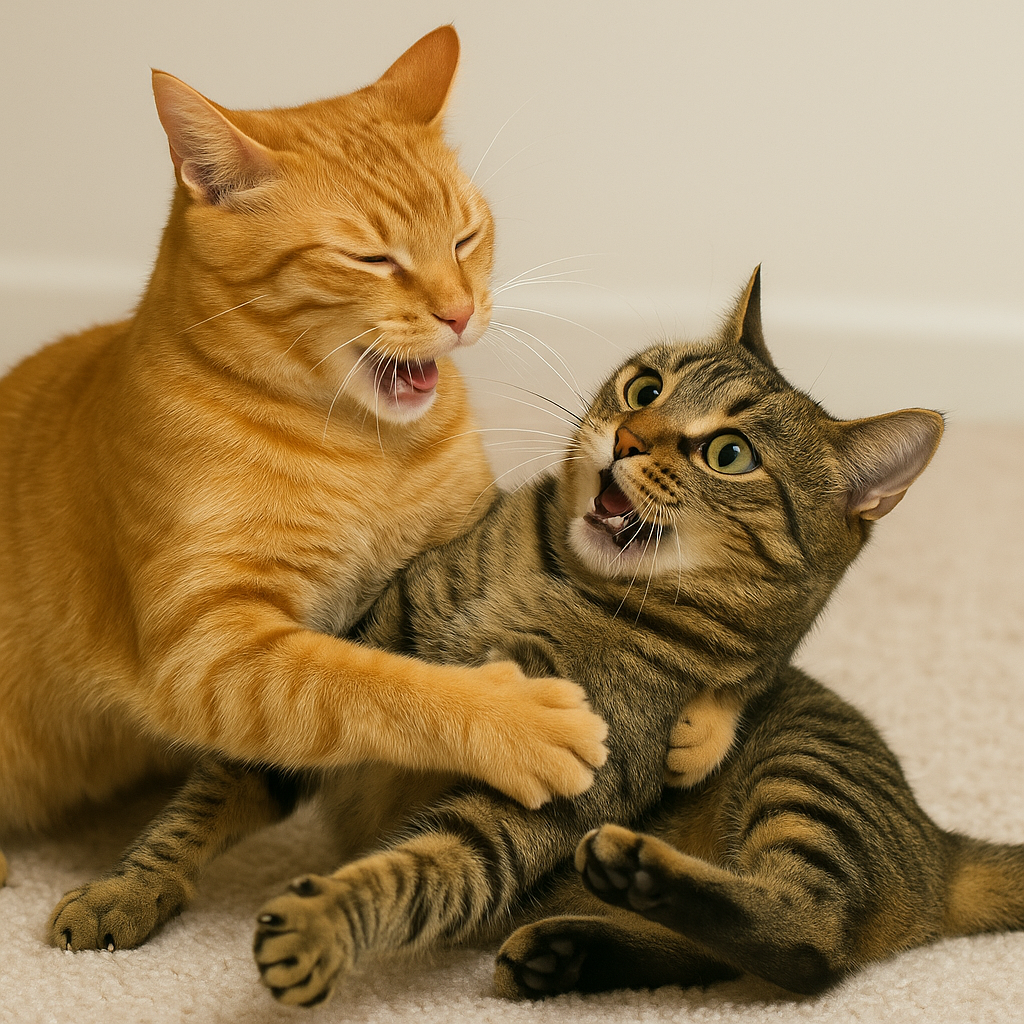Post Disclaimer
Catopedea shares information for educational and general interest purposes only. Our content is not a substitute for professional veterinary advice, diagnosis, or treatment. Always consult a licensed veterinarian for concerns about your cat’s health, diet, or behavior.
Living with multiple cats can be heartwarming until one of them starts getting too rough. A very common scenario cat parents face is when a male cat plays too rough with a female cat. At first glance, it might look like normal feline wrestling, but sometimes it can cross the line into stress, bullying, or even aggression.
Quick Fix:
- Schedule more interactive playtime with your male cat (wand toys, chase games) to burn off extra energy.
- Provide separate resources – litter boxes, food bowls, and resting spots – so neither cat feels forced to compete.
- Interrupt rough play by tossing a toy or making a gentle noise (like clapping) to distract them.
- If play escalates into true aggression, separate the cats for a cooldown period before slowly reintroducing them.
In this guide, we’ll break down:
- Why male cats often play rougher than female cats
- How to recognize the difference between play and aggression
- What you can do to calm the situation
- When to intervene and when to let them work it out
- Real-life cat parent experiences and solutions
By the end, you’ll know exactly how to create a safer, calmer environment for both of your cats.
Why Do Male Cats Play Rougher?

Male cats are naturally more physical when it comes to play. This doesn’t mean they’re mean it’s often about energy levels, hormones, and instinct.
1. Natural Wrestling Behavior
In the wild, young males often practice wrestling and chasing as preparation for hunting and defending territory. Your housecat may just be acting out instinctual play.
2. Size and Strength Differences
Male cats, especially if larger or more muscular, may unintentionally overwhelm smaller females. Even if he means no harm, she may feel intimidated.
3. Hormones and Neutering
Unneutered males are far more likely to play rough, sometimes confusing play with dominance or mating behaviors. Neutering usually reduces intensity but doesn’t always eliminate roughhousing.
4. Personality Mismatch
Sometimes it’s simply a case of clashing personalities: one cat thrives on rough-and-tumble play while the other prefers calm companionship.
How to Tell Play From Aggression
Not all rough play is dangerous but you need to know the warning signs.
✅ Normal Play:
- Taking turns being “on top”
- Chasing without cornering
- Biting but not breaking skin
- Minimal growling or hissing
- Both cats re-engage willingly
⚠️ Aggression or Bullying:
- One cat always pins or chases the other
- Hissing, growling, yowling from the female
- Fur puffing up, swatting with claws out
- The female hides or avoids interaction afterward
- Injuries (scratches, bite marks)
💡 Tip: A simple way to test if both cats immediately return to each other after a break, it’s likely play. If one runs away or hides, it’s crossed into aggression.
Emotional Dynamics Between Male and Female Cats

Competitor sites often overlook the emotional context. Cats aren’t just fighting machines they have stress, fear, and preferences.
- Past Trauma: A female cat that’s been bullied before may interpret rough play as threatening.
- Stress Factors: Moving homes, new pets, or even changes in your schedule can make cats more irritable.
- Territorial Instincts: A male may play rougher when he feels he needs to establish “alpha” behavior.
Real-Life Cat Parent Experiences
On forums and Reddit, cat owners often describe the exact same issue:
- “My 2-year-old male chases and pounces on my 5-year-old female. She hisses but he won’t stop. I’ve had to redirect with toys every time.”
- “At first I thought it was playing, but then I noticed she started hiding under the bed. That’s when I realized it was stressing her out.”
Including these real examples validates that you’re not alone and shows there are tried solutions.
What To Do When a Male Cat Plays Too Rough With a Female
Here’s a structured 4-phase play therapy plan you can use.
Phase 1: Observation & Note Triggers
- Write down when and why the rough play happens (after meals, evenings, during boredom).
- Notice if certain toys or areas of the house are triggers.
Phase 2: Redirect Rough Play
- Keep wand toys or feather teasers handy redirect the male cat’s energy onto toys.
- Use interactive play sessions (10–15 mins twice daily) to burn excess energy.
- Never use your hands as toys it reinforces rough play.
Phase 3: Create Safe Zones
- Provide vertical spaces (cat trees, shelves) where the female can retreat.
- Give each cat separate feeding spots and litter boxes (rule: one per cat + 1 extra).
- Set up hiding areas that only the smaller cat can access.
Phase 4: Positive Reinforcement
- Reward calm interaction with treats.
- If the male cat disengages when redirected, praise immediately.
- Gradually allow supervised play, extending time as long as both cats remain relaxed.
When to Intervene (and When Not To)
- Don’t intervene if both cats are quietly wrestling, no hissing, and they take turns.
- Do intervene if:
- One cat looks distressed
- The female is always chased or pinned
- Fur, claws, or injuries are involved
Best way to break it up: distract with a toy or clap once – never grab them mid-fight (you could get bitten). For more safety tips on handling cat fights, check out PetMD’s guide on breaking up cat fights.
Could It Be Medical?
If your male suddenly starts playing rougher than usual, consider medical issues:
- Pain in one cat making them more defensive
- Overactive thyroid or other conditions that raise energy
- Stress-related behavior changes
When in doubt, a vet check is wise.
Long-Term Solutions
- Neuter/Spay if not done: reduces hormone-driven behaviors.
- Routine Play: daily exercise keeps both cats mentally balanced.
- Feliway or calming diffusers: help reduce territorial tension.
- Behavioral training: in extreme cases, consult a feline behaviorist.
Frequently Asked Questions (FAQs)
1. How do I know if my cats are playing too rough?
Watch body language, if both take turns and re-engage, it’s likely play. If one cat hides or hisses constantly, it’s too rough
2. Why does my male cat always bully my female?
It’s often excess energy, dominance instinct, or mismatched personalities. Redirecting with toys helps.
3. Will neutering my male cat stop rough play?
Neutering usually reduces intensity but won’t always eliminate roughhousing. Play redirection is still important.
4. Should I separate my cats when they fight?
Yes, but separate gently. Distract with toys and give each safe space. Avoid punishment it increases fear.
5. How do I make my cats get along?
Slow introductions, plenty of resources, and rewarding calm behavior. Use vertical space to reduce territorial conflict.
Conclusion
It can be worrying when a male cat plays too rough with a female, but most of the time, it’s manageable with patience and the right techniques. Rough play is often just misplaced energy not cruelty. By observing triggers, redirecting with toys, giving your female cat safe zones, and rewarding calm play, you can create a more balanced environment. If the behavior escalates or causes stress and injury, consult your vet or a behaviorist. With time, most cats learn to coexist and even enjoy each other’s company.
Looking for more cat behavior guides? Visit Catopedea for in-depth advice tailored to cat parents.



Pingback: Why Is My Cat Growling All of a Sudden? Understanding Feline Aggression - catopedea.com